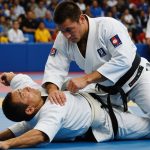The Importance of Focus in Dressage Competitions
In dressage competitions, focus stands as a fundamental pillar influencing successful outcomes. Harnessing effective focus techniques enables riders to deliver high-level performances, even when faced with distractions. In this arena, mental resilience is not merely advantageous; it is essential.
The impact of focus on competitive performance is profound. Riders who master the art of concentration can maintain composure, ensuring their movements are precise and fluid. This translates into higher scores and more compelling presentations. Dressage, often characterised by its demand for synchronicity and elegance, requires undivided attention from both horse and rider. A lapse in focus can lead to errors, highlighting the necessity of sustained concentration.
In parallel : Elevate your cricket game: unleashing ultimate fielding agility with expert strategies
Mental resilience in high-pressure environments acts as a buffer against anxiety and mistakes. Competitors must cultivate this resilience to remain calm and perform optimally. Techniques such as controlled breathing and visualisation are often employed to enhance focus. They allow riders to block out external distractions and maintain a clear, centred mindset.
By connecting focus techniques with improved dressage outcomes, riders can achieve greater control and harmony with their horses. Practising these techniques regularly strengthens mental alertness and composure. Through such dedication, competitors can elevate their performance, embodying grace and precision under the keen eyes of judges.
This might interest you : Mastering grip strength: key techniques for judo athletes to elevate performance
Visualization Techniques for Success
Visualization strategies are crucial for anyone aiming to boost performance, especially in competitive settings. At the heart of these strategies is mental imagery, a powerful tool used by top athletes and performers. Mental imagery involves creating vivid and detailed pictures in your mind, simulating successful outcomes and scenarios as though you’re experiencing them in reality. It enhances your ability to perform tasks by preparing your brain and body for the experience.
The Power of Mental Imagery
Mental imagery is more than just a mental exercise; it is a rehearsal that fine-tunes your physical and psychological responses. By visualizing the process and the end goal, you positively align your mental state with the objectives, ultimately leading to performance enhancement. This imagery helps create neural patterns in the brain that impact real-world actions.
Creating a Pre-Competition Routine
Embedding visualization into a pre-competition routine ensures consistency and focus. Start by mentally rehearsing your actions step-by-step, envisioning overcoming obstacles and celebrating your success. This routine builds confidence and reduces anxiety, allowing you to enter competitions with the right mindset.
Techniques for Effective Visualization
To implement effective visualization strategies, follow these steps:
- Engage all senses for a comprehensive experience.
- Practice regularly to make visualization second nature.
- Share insights and stories from those who have successfully utilized these techniques.
By focusing on these performance enhancement strategies, competitors can leverage visualization techniques to achieve their desired results.
Mindfulness Practices for Competitors
Embracing mindfulness techniques can transform any competitor’s experience by reducing stress and enhancing performance. Whether you’re in the densely focused world of dressage or another competitive field, understanding and practising mindfulness can be immensely beneficial.
Benefits of Mindfulness in Dressage
Mindfulness encourages greater awareness training, fostering deeper connections between riders and their environment. Practising mindfulness techniques improves stress reduction, enabling competitors to perform under pressure with increased calm and precision. With consistent practice, mindfulness can help sharpen focus and augment performance when it matters most.
Simple Mindfulness Exercises
Competitors can engage in simple yet effective mindfulness techniques to bolster focus and reduce anxiety. For instance:
- Breathing exercises: Focus on your breathing, taking slow, deliberate breaths to centre yourself before a competitive event.
- Body scans: Notice tense areas in your body and consciously relax them to improve flexibility and responsiveness.
- Visualisation: Envision successful scenarios, reinforcing positive outcomes and self-confidence.
Incorporating Mindfulness into Training
Integrating mindfulness into your training routine can significantly enhance overall performance. Begin by establishing a mindfulness routine that aligns with your daily training, incorporating exercises such as breathing techniques and visualisation. Over time, these practices build resilience, maintain mental agility, and ensure competitors remain calm and focused amidst the demands of competition.
Breathing Exercises to Manage Stress
Understanding the profound connection between our breath and emotional well-being can be transformative for stress management. The role of breath in staying calm is critical, serving as the anchor that grounds us during everyday life. In essence, conscious breathing techniques influence the parasympathetic nervous system, which helps diminish stress responses.
Understanding the Role of Breath
Breathing is intrinsically linked to our nervous system’s functions. By optimizing your breathing techniques, you can improve mental clarity and foster relaxation. Deep and purposeful belly breathing can activate the body’s natural relaxation response, reducing tension caused by stress.
Effective Breathing Techniques
Several relaxation methods focus on breathing techniques that are simple yet powerful:
- Diaphragmatic breathing: Engage the diaphragm as you inhale, filling your lungs fully and exhaling slowly.
- Box breathing: Inhale for four counts, hold for four, exhale for four, and pause again for four. Repeat to promote calmness.
- Resonant breathing: Find a pace in which your breaths per minute decrease but feel natural and soothing.
Timing Breathing with Riding
Aligning breath with physical activity, such as riding, can enhance performance. By timing breaths with movements, you create rhythm and synchrony, bolstering efficiency while riding. Conscious, deliberate breathing supports stamina, allowing the body to adapt and sustain energy throughout physical exertion.
Goal-Setting Strategies for Dressage Competitors
Understanding how to effectively set goals is fundamental in dressage, playing a crucial role in enhancing both focus and performance. Let’s explore some practical goal-setting techniques to aid dressage competitors in achieving their aspirations.
The Importance of Clear Goals
Clear goals empower dressage competitors by honing their focus and channeling their efforts toward specific achievements. By having well-defined performance goals, competitors can enhance their motivation and track progress more efficiently. A clear goal provides a roadmap that contributes to sustained motivation and consistent improvement, thus becoming an indispensable achievement strategy in the competitive arena.
SMART Goals Framework in Dressage
One of the most effective goal-setting techniques is the SMART framework. SMART stands for Specific, Measurable, Achievable, Relevant, and Time-bound. This method emphasizes precision and practicality, ensuring each goal is tailored to the individual’s unique performance context. By setting SMART goals, dressage competitors increase their chances of success by ensuring their goals are not only meaningful but also attainable.
Revisiting and Adjusting Goals
With performance goals, continual reassessment is necessary. Dressage competitors should periodically review and adjust their goals to adapt to changing circumstances and personal growth. This practice involves evaluating what has been accomplished and what adjustments are necessary for further progress. Employing these achievement strategies encourages sustained focus and development throughout the competitive season.
Expert Insights and Real-Life Examples
Understanding expert strategies and applying them can be the key to unlocking your potential in dressage competitions. By learning from competitor advice and real-life success stories, you can craft your path to excellence.
In many interviews, dressage professionals emphasize the importance of focus techniques. They often stress the need to foster a mental environment where the rider can perform optimally despite stressors. Techniques like visualization and mindfulness practice are frequently mentioned, allowing riders to concentrate on every detail of their performance.
Consider the case of Charlotte Dujardin, a globally celebrated dressage rider. Her success is often attributed to finely-tuned mental strategies and the guidance of skilled coaches. These case studies underscore the value of commitment and mindset in mastering dressage.
The role of coaching is undeniably significant in developing these mental strategies for competitions. Coaches provide crucial support and tailored advice, enabling riders to navigate challenges effectively. Through personalized training, they help riders harness their cognitive strengths and manage anxiety.
To sum up, integrating these real-life success strategies into your competitive routine can enhance performance and mental resilience. By employing expert strategies, listening to competitor advice, and seeking quality coaching, you pave the way for your own achievements in the world of dressage.
Engaging Visuals and Demonstrative Techniques
Incorporating visual aids is crucial for enhancing understanding and retention of complex ideas. Techniques like video tutorials and infographics can significantly improve instructional content by visually demonstrating procedures and strategies.
Video Tutorials on Focus Techniques
Video tutorials serve as a powerful medium to demonstrate focus techniques effectively. They allow viewers to observe the step-by-step application of techniques, offering a dynamic and engaging learning experience. For instance, a video showcasing meditation techniques can include guided sessions that help users understand and practise focusing methods in real-time, fostering a deeper connection with the material.
Infographics Summarizing Key Strategies
Infographics are an excellent way to summarize key strategies succinctly. By combining text and visuals, they make complex data more accessible and engaging. An infographic breaking down the essentials of time management could include bullet points on prioritization methods, thus helping readers quickly grasp and implement these strategies.
Interactive Elements for Reader Engagement
Interactive elements such as quizzes or scenario-based exercises can significantly enhance reader engagement with instructional content. These techniques encourage active participation, allowing readers to apply what they’ve learned in simulated settings. This hands-on approach reinforces learning and helps readers test and refine their understanding of various techniques.











